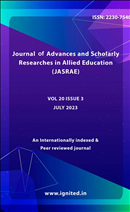The Pros or Cons of Agile and Traditional IT Project Management
A Comparative Analysis of Agile and Traditional IT Project Management
Keywords:
Agile, Traditional IT Project Management, pros, cons, managing complicated projects, flexibility, iterative nature, collaboration, customer input, gradual progress, risk reduction, scope creep, uncertainty, schedules, prices, comparison, conventional IT project managementAbstract
Agile and Traditional IT Project Management both have pros and cons for managingcomplicated projects. Agile teams can quickly adjust to new needs due to its flexibility and iterativenature. Collaboration, customer input, and gradual progress reduce the risk of producing a product thatdoesn't fulfil user demands. However, its informality may cause scope creep and uncertainty aboutschedules and prices. This article compares agile and conventional IT project management.References
Cockburn, A. (2022). Agile software development. Addison-Wesley Professional.
Royce, W. W. (2018). Managing the development of large software systems. Proceedings of IEEE WESCON.
Boehm, B. W., & Turner, R. (2019). Using risk to balance agile and plan-driven methods. Computer, 36(6), 57-66.
Abrahamsson, P., Salo, O., Ronkainen, J., &Warsta, J. (2022). Agile software development methods: Review and analysis. In 24th International Conference on Software Engineering (ICSE 2002) (pp. 317-324). IEEE.
Highsmith, J. A. (2021). The agile manifesto revisited. ACM Software Engineering Notes, 29(5), 16-18.
Project Management Institute. (2017). Pulse of the Profession®: Success Rates Rise: Transforming the High Cost of Low Performance.
Standish Group. (2020). CHAOS Report 2020: Beyond Agile.
Government Accountability Office. (2018). Information Technology: Agencies Need to Develop Modernization Plans for Critical Legacy Systems.
Schwaber, K. (2018). Agile Project Management with Scrum. Microsoft Press.
Sutherland, J. (2019). Scrum: The Art of Doing Twice the Work in Half the Time. Crown Business.
Schwaber, K., & Sutherland, J. (2017). The Scrum Guide. Scrum.org.
Leffingwell, D. (2020). Agile Software Requirements: Lean Requirements Practices for Teams, Programs, and the Enterprise. Addison-Wesley Professional.
Larman, C., & Vodde, B. (2019). Scaling Lean & Agile Development: Thinking and Organizational Tools for Large-Scale Scrum. Addison-Wesley Professional.
Beck, K., Beedle, M., Van Bennekum, A., Cockburn, A., Cunningham, W., Fowler, M., ... & Thomas, D. (2021). Manifesto for agile software development. Agile Alliance.
Boehm, B., & Lane, J. A. (2017). Combining agile practices with stage-gate project management. IEEE Software, 24(3), 18-24.











